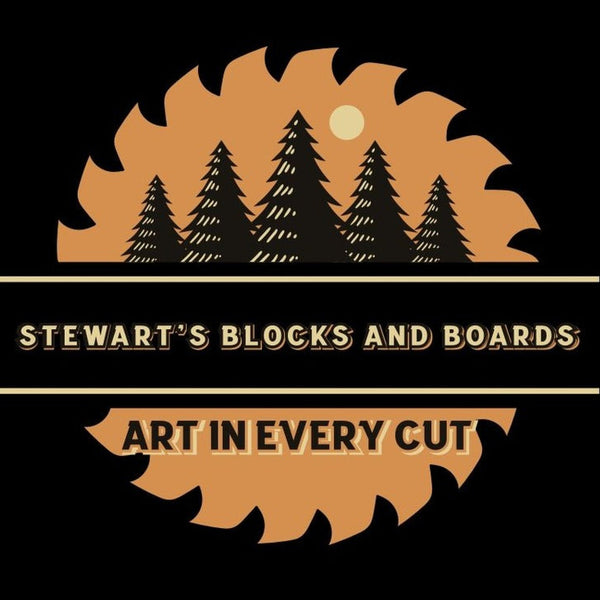
Solving Common Handcrafted Cutting Board Challenges
Share
When it comes to kitchen essentials, handcrafted cutting boards and butcher blocks are more than just tools; they are cornerstones of culinary craft and artistry. Whether you’re an enthusiastic home cook or a seasoned chef, these handcrafted pieces provide both functionality and aesthetic appeal. At Stewart's Blocks and Boards, we celebrate the art of fine kitchenware with our meticulously crafted cutting boards, butcher blocks, and Lazy Susans.
Understanding Handcrafted Cutting Boards
Handcrafted cutting boards aren't just about the wood – they're about the marriage of purpose and design. Each board comes with its own set of characteristics and challenges. Understanding these can transform your kitchen experience.
Choosing the Right Wood Type
Different types of wood have different densities and grain patterns, affecting a cutting board's durability and knife-friendliness. For example, cherry and walnut are popular choices for their balance of hardness and aesthetic beauty.
- Cherry Wood: Known for its rich grain and stunning color, like our Cheese Slicer Cherry, cherry wood provides clean cuts and a charming addition to any kitchen.
- Black Walnut: Embrace boldness in your kitchen with our Black Walnut Cheese Slicer. This wood is favored for its robustness and wealthy hue.
Maintaining and Caring for Your Boards
Handcrafted cutting boards require special attention to maintain their integrity and beauty. Regular maintenance includes:
- Oiling Your Boards: Regular application of mineral oil or beeswax helps in maintaining the board's moisture and sheen. This prevents cracking and warping over time.
- Regular Cleaning: Always hand wash your board with lukewarm, soapy water after each use. Avoid soaking them, as excess water can cause warping.
- Proper Storage: Store your boards in a dry area, ensuring air circulates around them. Avoid placing them against countertops where moisture can accumulate.
Addressing Common Challenges
While owning a handcrafted cutting board is rewarding, it can present specific challenges that require attention and care.
Knife Marks and Maintenance
One common concern with cutting boards is managing knife marks over time.
- Solution: Rotate your board regularly to ensure even wear. Refinishing your board with fine sandpaper can help smooth out deeper marks. For bread slicing, consider our Black Limba Bread Knife, designed to handle crust cutting with precision and extend the life of your boards.
Preventing Odors and Stains
Foods like garlic, onion, and beetroot can leave unpleasant odors or stains on your board.
- Solution: After use, rub the board with coarse salt and a lemon half. This natural combination helps remove residue and smells while keeping your board fresh.
Ensuring Stability During Use
A common inconvenience is a shifting board during use.
- Solution: Place a damp towel or non-slip mat under your board to keep it secure on your countertop. This simple trick can significantly enhance your cutting precision.
The Versatility of Handcrafted Butcher Blocks
Handcrafted butcher blocks serve a dual purpose in any kitchen: they are both cutting surfaces and stunning presentation pieces. Understanding how to leverage their strengths can enhance daily cooking tasks.
Choosing the Right Size and Thickness
Butcher blocks are available in various sizes and thicknesses, making them versatile for different culinary needs.
- Functionality: Consider the size of your kitchen and the type of food preparation you do most frequently. For everyday cooking and more substantial preparations, a thicker block offers durability and stability.
Achieving and Maintaining Smoothness
The smoothness of a butcher block affects both its utility and aesthetic appeal.
- Regular Buffing: Over time, butcher blocks can become rough due to frequent use. Regular buffing with fine sandpaper lets you maintain a velvety finish.
Resilience Against Moisture and Stains
Similar to cutting boards, butcher blocks require diligent maintenance against moisture and stains to retain their premium quality.
- Protective Sealing: Using a food-safe sealant will add an extra layer of protection against moisture. More so, regular oiling aids in keeping the butcher block in pristine condition.
Revolutionizing Dining with a Handcrafted Lazy Susan
Handcrafted Lazy Susans are not only elegant centerpieces but also functional dining accessories that streamline serving at family dinners or social gatherings.
Choosing Your Lazy Susan Design
From sleek minimalism to rustic charm, the design of a Lazy Susan can redefine your dining experience.
- Material Matters: Wood choice not only impacts durability but also enhances the dining table's visual appeal. A handcrafted Lazy Susan can seamlessly blend with or accentuate your existing décor.
Making the Most of Your Lazy Susan
To maximize the utility of a Lazy Susan, consider the following:
- Weight Distribution: Place heavier items in the center to prevent tipping and ensure smooth rotation.
- Seasonal Decor: Beyond dining, use a Lazy Susan as a base for seasonal decorations, centering flowers or thematic decor pieces.
Closing Thoughts
Handcrafted cutting boards, butcher blocks, and Lazy Susans from Stewart's Blocks and Boards are more than utilitarian objects—they are a testament to the exquisite craftsmanship that invites creativity into your kitchen. By addressing common challenges and incorporating these fine pieces into your culinary adventures, you can enhance both the functionality and ambiance of your kitchen.
Explore the artistry of Stewart's handcrafted products further at Stewart's Blocks and Boards. Whether for crafting a precise cheese slice or wielding artisanal knives, your kitchen deserves the undeniable touch of craftsmanship.


